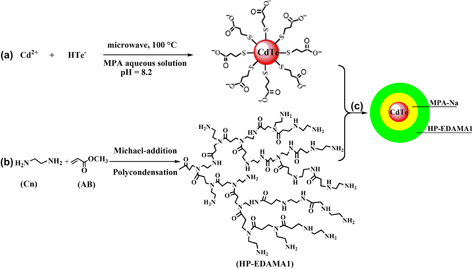Crossref Citations
This article has been cited by the following publications. This list is generated based on data provided by
Crossref.
Yao, Jun
Yang, Mei
and
Duan, Yixiang
2014.
Highly fluorescent CdTe nanocrystals: Synthesis, characterization, property, mechanism, and application as a sensor for biomolecule analysis.
Journal of Materials Research,
Vol. 29,
Issue. 5,
p.
633.
Shi, Yunfeng
Ma, Zhimin
Cui, Ningning
Liu, Yanli
Hou, Xiaoyu
Du, Weimin
Liu, Lin
and
Gangsheng, Tong
2014.
In situ preparation of fluorescent CdTe quantum dots with small thiols and hyperbranched polymers as co-stabilizers.
Nanoscale Research Letters,
Vol. 9,
Issue. 1,
ZHANG, LEI
and
WU, JING-SHEN
2014.
ACCELERATING QUANTUM DOTS' SYNTHESIS IN AQUEOUS PHASE WITH LIMITED QUANTITY OF 1,2-DIAMINOETHANE THROUGH AMINE-PROMOTION.
Nano,
Vol. 09,
Issue. 06,
p.
1450064.
Xue, Jingjing
Chen, Xinyi
Liu, Shanglin
Zheng, Fenfen
He, Li
Li, Lingling
and
Zhu, Jun-Jie
2015.
Highly Enhanced Fluorescence of CdSeTe Quantum Dots Coated with Polyanilines via In-Situ Polymerization and Cell Imaging Application.
ACS Applied Materials & Interfaces,
Vol. 7,
Issue. 34,
p.
19126.
Munshi, Alaa M.
Kretzmann, Jessica A.
Evans, Cameron W.
Ranieri, Anna M.
Schildkraut, Zibeon
Massi, Massimiliano
Norret, Marck
Saunders, Martin
and
Iyer, K. Swaminathan
2020.
Dendronised Polymers as Templates for In Situ Quantum Dot Synthesis.
Australian Journal of Chemistry,
Vol. 73,
Issue. 7,
p.
658.
Mirica, Andreea-Cristina
Stan, Dana
Chelcea, Ioana-Cristina
Mihailescu, Carmen Marinela
Ofiteru, Augustin
and
Bocancia-Mateescu, Lorena-Andreea
2022.
Latest Trends in Lateral Flow Immunoassay (LFIA) Detection Labels and Conjugation Process.
Frontiers in Bioengineering and Biotechnology,
Vol. 10,
Issue. ,
Yukselici, Mehmet Hikmet
Torun, M. K.
Bozkurt, Asuman A.
Patan Alper, Melda
Nassar, Zaher M.
Bulut, Damla
and
Balaban, Mesut
2022.
Progress in Nanoscale and Low-Dimensional Materials and Devices.
Vol. 144,
Issue. ,
p.
181.
